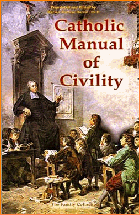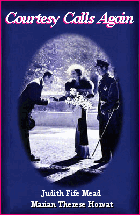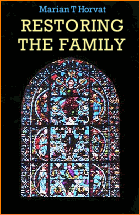Formation of Children
 |
 |
 |
 |
 |
 |
 |
Movies for Families - 2
The Bad Spirit of Spontaneity
& Optimism in Movies
In our last article, we showed how errors and objectionable scenes were present in even the very early movies in Hollywood. The first errors we examined to help our readers analyze what they watch were romanticism and impurity, egalitarianism and Masonic liberty, and a constant belittling of royality and nobility
Other errors to look for in movies that often walk hand in hand are a lack of seriousness, spontaneity and optimism.
The non-serious & spontaneous man is exalted
/A083_Sin.jpg)
/A083_Sof.jpg) The lack of seriousness is an important point to look for in movies, if you want your children to be well formed. The constant insertion of a joke or a situation that makes people laugh has behind it a philosophy: Nothing in life should be taked seriously.
The lack of seriousness is an important point to look for in movies, if you want your children to be well formed. The constant insertion of a joke or a situation that makes people laugh has behind it a philosophy: Nothing in life should be taked seriously.
This approach is the very opposite of the Catholic position, which considers that everyhting is serious, important and has grave consequences. We will have to give an account to God for everyhting we do in this life.
One consequence of this lack of seriousness is spontaneity, which has long been exalted in the United States. The spontaneous man says what he thinks, does what he wants, and encourages others to break the rules. This American myth of spontaneity, as is described in Courtesy Calls Again (Chapter 3), took hold in Hollywood productions from its earliest years.
A prime example of the spontaneous man is the main character in the popular film It’s a Wonderful Life, Mr. George Bailey, who jokes with everyone and loudly proclaims his opinions.
Other examples include Maria from The Sound of Music, Anne from Anne of Green Gables, Indiana Jones, Father O’Malley in Going My Way, most of the recent Disney princesses including Rapunzel, Anna, Giselle from Enchanted, etc.
It is indeed rare to find a movie that honors the true gentleman, ordered and refined in his every thought, word and action. The same may be said of the true lady: Tainted with feminism, the women on screen are models of spontaneity instead of the ceremonious, modest ladies of the past. Even if the main character is presented as courteous and serious, a spontaneous side character invariably appears to offer “relief” to the sobriety.
/A083_Aud.jpg) Instead of viewing this world as a pilgrimage to our true home in heaven, the optimist proudly proclaims that happiness can be found in this world so long as everyone says nice things about others and tolerates every moral vice. The important thing is that everyone should feel good. Deep down, the optimist believes that no one is really bad and that all things will be made right in the world if we only trust in human goodness.
Instead of viewing this world as a pilgrimage to our true home in heaven, the optimist proudly proclaims that happiness can be found in this world so long as everyone says nice things about others and tolerates every moral vice. The important thing is that everyone should feel good. Deep down, the optimist believes that no one is really bad and that all things will be made right in the world if we only trust in human goodness.
The musical Annie provides a clear example of this mentality in the song “Tomorrow.” Here Annie muses: “The sun’ll come out, tomorrow... Just thinking about, tomorrow / Clears away the cobwebs, and the sorrow / 'Til there's none!”
/A083_Ani.jpg) Instead of embracing the crosses of everyday life and accepting suffering for the love of God, Annie sings that we should forget our sorrows by dreaming of the future pleasures of this life. This Protestant worldview that rejects suffering is frontally opposed to the Catholic understanding of suffering as a gift from God, an invitation to take up our cross and follow in the footsteps of Our Lord.
Instead of embracing the crosses of everyday life and accepting suffering for the love of God, Annie sings that we should forget our sorrows by dreaming of the future pleasures of this life. This Protestant worldview that rejects suffering is frontally opposed to the Catholic understanding of suffering as a gift from God, an invitation to take up our cross and follow in the footsteps of Our Lord.
Of all movies, perhaps the best illustration of the "perfect" coupling of spontaneity and optimism is Pollyanna (1960). In this movie, a little orphan – Pollyanna – comes to live with her proper but bitter aunt. Her aunt attempts to make a lady of Pollyanna, but the young charismatic girl is too given to spontaneity and cheerful optimism to fit into what appears as the cold and rigid world of refinement and decorum.
/A083_Pol.jpg) Further, Pollyanna has the American celebrated "gift" of frankness, which makes her tell others what she thinks about them, which is what she does in an entertaining way throughout the film. And, even when she does not speak, her face dramatically reveals all of her impressions in a very unladylike manner.
Further, Pollyanna has the American celebrated "gift" of frankness, which makes her tell others what she thinks about them, which is what she does in an entertaining way throughout the film. And, even when she does not speak, her face dramatically reveals all of her impressions in a very unladylike manner.
Of course, in the end the optimistic Pollyanna manages to change the whole town into a friendlier place, with even the fiery old-school Protestant preacher “converting” to the American "gospel" of optimism and joy.
Yet, in the end, the true fate of the spontaneous optimist is momentarily revealed: Pollyanna’s legs are paralyzed and she lies in bed sulking over her great misfortune. Unable to understand suffering, Pollyanna will only be comforted when hope of recovery and a return to the good life is offered. Without this, we have the impression she would spend the rest of her life in anger and bitterness at her cruel fate.
Good books read aloud vs. on screen movies & cartoons
Having set forth these principles – which, let us note, only covers a small portion of the errors in movies – the reader may wonder whether it is worthwhile to watch movies at all.
/A083_Que.jpg) In truth, a better form of entertainment is reading stories aloud together as a family. In this way, each person is able to imagine the story without the screen that often manipulates both
the young and the old. Further, as anyone who has read a book and then watched a screenplay knows, the story almost always suffers in the movie adaptation.
In truth, a better form of entertainment is reading stories aloud together as a family. In this way, each person is able to imagine the story without the screen that often manipulates both
the young and the old. Further, as anyone who has read a book and then watched a screenplay knows, the story almost always suffers in the movie adaptation.
The highest and purest ideals cannot be expressed through actors and videos, but the words of a good book with marvelous illustrations can evoke the intangible. Even a fairy tale, viewed on screen with actors or cartoon characters, loses its depth of meaning and moral beauty, precisely because what is depicted in the good fairy tale lies beyond what can be seen in this world and nourishes the sense of the marvelous.
Notwithstanding, if one feels the need to watch movies with the family, some general recommendations can be made. First, a caveat: The screen can become very addictive for children and adults alike. If children are constantly watching movies and cartoons, they can quickly lose their innocence and imagination. In view of this, it is best to watch movies very seldom, ideally no more than once a month.
In order to maintain hierarchy and order in the home, it is important that the parents choose the movies to watch. Children should not be allowed to make the decisions, demanding to see the same movie over and over, as so often happen in modern homes. The movie should be a source of entertainment for the whole family.
In our opinion, there are no movies that are not tainted with some error. In the list provided below, we have noted the main errors of the film. As the understanding of the Counter-Revolution grows in a Catholic, he should try to analyze each movie looking for these tendencies, and then discuss them with the older children so that they do not swallow the mistakes.
Finally, before viewing the film together, the parents should have previewed them so that they are prepared to skip over any romantic scenes or other questionable instances.
Movie recommendations
The movies listed below are the more innocent we have seen, but are by no means perfect. They have been chosen because the female characters have a general modesty, the men are masculine and the women feminine, the plot is not overly confusing or revolutionary, and a good moral lesson is typically upheld at some part of the movie.
We prefer movies made before 1970, because they tend to be made in the style of a play with the sets and personality of the actors emphasized, making it easier for the viewer to maintain a psychological distance from the plot and drama of the movie. Modern movies tend to draw the viewer into their worlds, evoking strong passions and uncontrolled emotions that can manipulate the way the viewer sees the material world and understands the spiritual. This is done using dramatic music, intense acting and fast scene changes.
/A083_Old.jpg)
/A083_Mar.jpg)
/A083_Bal.jpg)
/A083_Tho.jpg)
/A083_Cha.jpg) If any of our readers would like to offer suggestions for other movies, we will consider adding them to the list.
If any of our readers would like to offer suggestions for other movies, we will consider adding them to the list.
The following musicals are generally decent, with the least amount of romantic scenes of the genre, but be aware they are still infected to some degree with many of the above errors:
The Passion of Christ (2004) comes closest to a Catholic portrayal of Christ and a honest representation of the Pharisees and Scribes, although it also is not perfect (especially in the naturalistic portrayal of Our Lady and occasional joking tone).
/A083_Car.jpg) Le dialogue des Carmélites (1960) – which tells the story of the nun martyrs of Compiègne who
were guillotined in Paris during the French Revolution – is perhaps the best Catholic film that we have seen. Its main error is the spontaneity and optimism shown in one of the novices, but this is not enough to detract from the overall effect of the movie, especially the final scene when the Carmelites heroically climb the steps to the scaffold one by one.
Le dialogue des Carmélites (1960) – which tells the story of the nun martyrs of Compiègne who
were guillotined in Paris during the French Revolution – is perhaps the best Catholic film that we have seen. Its main error is the spontaneity and optimism shown in one of the novices, but this is not enough to detract from the overall effect of the movie, especially the final scene when the Carmelites heroically climb the steps to the scaffold one by one.
Most of the other saint movies produced by Hollywood seem overly sentimental, progressivist and poorly made.

Other errors to look for in movies that often walk hand in hand are a lack of seriousness, spontaneity and optimism.
The non-serious & spontaneous man is exalted
/A083_Sin.jpg)
Lack of seriousness in early Hollywood stars
/A083_Sof.jpg)
This approach is the very opposite of the Catholic position, which considers that everyhting is serious, important and has grave consequences. We will have to give an account to God for everyhting we do in this life.
One consequence of this lack of seriousness is spontaneity, which has long been exalted in the United States. The spontaneous man says what he thinks, does what he wants, and encourages others to break the rules. This American myth of spontaneity, as is described in Courtesy Calls Again (Chapter 3), took hold in Hollywood productions from its earliest years.
A prime example of the spontaneous man is the main character in the popular film It’s a Wonderful Life, Mr. George Bailey, who jokes with everyone and loudly proclaims his opinions.
Other examples include Maria from The Sound of Music, Anne from Anne of Green Gables, Indiana Jones, Father O’Malley in Going My Way, most of the recent Disney princesses including Rapunzel, Anna, Giselle from Enchanted, etc.
It is indeed rare to find a movie that honors the true gentleman, ordered and refined in his every thought, word and action. The same may be said of the true lady: Tainted with feminism, the women on screen are models of spontaneity instead of the ceremonious, modest ladies of the past. Even if the main character is presented as courteous and serious, a spontaneous side character invariably appears to offer “relief” to the sobriety.
/A083_Aud.jpg)
Audrey Hepburn, provocative & spontaneous
The musical Annie provides a clear example of this mentality in the song “Tomorrow.” Here Annie muses: “The sun’ll come out, tomorrow... Just thinking about, tomorrow / Clears away the cobwebs, and the sorrow / 'Til there's none!”
/A083_Ani.jpg)
Annie in her short dress spontaneously enters into dance with an adult, whom she treats as an equal
Of all movies, perhaps the best illustration of the "perfect" coupling of spontaneity and optimism is Pollyanna (1960). In this movie, a little orphan – Pollyanna – comes to live with her proper but bitter aunt. Her aunt attempts to make a lady of Pollyanna, but the young charismatic girl is too given to spontaneity and cheerful optimism to fit into what appears as the cold and rigid world of refinement and decorum.
/A083_Pol.jpg)
Pollyanna, frank, spontaneous & unladylike
Of course, in the end the optimistic Pollyanna manages to change the whole town into a friendlier place, with even the fiery old-school Protestant preacher “converting” to the American "gospel" of optimism and joy.
Yet, in the end, the true fate of the spontaneous optimist is momentarily revealed: Pollyanna’s legs are paralyzed and she lies in bed sulking over her great misfortune. Unable to understand suffering, Pollyanna will only be comforted when hope of recovery and a return to the good life is offered. Without this, we have the impression she would spend the rest of her life in anger and bitterness at her cruel fate.
Good books read aloud vs. on screen movies & cartoons
Having set forth these principles – which, let us note, only covers a small portion of the errors in movies – the reader may wonder whether it is worthwhile to watch movies at all.
/A083_Que.jpg)
Stories of Saints & fairy tales help develop the sense of marvelous
The highest and purest ideals cannot be expressed through actors and videos, but the words of a good book with marvelous illustrations can evoke the intangible. Even a fairy tale, viewed on screen with actors or cartoon characters, loses its depth of meaning and moral beauty, precisely because what is depicted in the good fairy tale lies beyond what can be seen in this world and nourishes the sense of the marvelous.
Notwithstanding, if one feels the need to watch movies with the family, some general recommendations can be made. First, a caveat: The screen can become very addictive for children and adults alike. If children are constantly watching movies and cartoons, they can quickly lose their innocence and imagination. In view of this, it is best to watch movies very seldom, ideally no more than once a month.
In order to maintain hierarchy and order in the home, it is important that the parents choose the movies to watch. Children should not be allowed to make the decisions, demanding to see the same movie over and over, as so often happen in modern homes. The movie should be a source of entertainment for the whole family.
In our opinion, there are no movies that are not tainted with some error. In the list provided below, we have noted the main errors of the film. As the understanding of the Counter-Revolution grows in a Catholic, he should try to analyze each movie looking for these tendencies, and then discuss them with the older children so that they do not swallow the mistakes.
Finally, before viewing the film together, the parents should have previewed them so that they are prepared to skip over any romantic scenes or other questionable instances.
Movie recommendations
The movies listed below are the more innocent we have seen, but are by no means perfect. They have been chosen because the female characters have a general modesty, the men are masculine and the women feminine, the plot is not overly confusing or revolutionary, and a good moral lesson is typically upheld at some part of the movie.
We prefer movies made before 1970, because they tend to be made in the style of a play with the sets and personality of the actors emphasized, making it easier for the viewer to maintain a psychological distance from the plot and drama of the movie. Modern movies tend to draw the viewer into their worlds, evoking strong passions and uncontrolled emotions that can manipulate the way the viewer sees the material world and understands the spiritual. This is done using dramatic music, intense acting and fast scene changes.
/A083_Old.jpg)
Old Yeller, a classic movie in which
a boy learns to be a man
/A083_Mar.jpg)
Feminism: the suffragette scene in Mary Poppins
/A083_Bal.jpg)
A boy finds & is faithful to his ideal in The Red Balloon
/A083_Tho.jpg)
Thomas Morus makes the heroic decision to disagree with the King in A Man for All Seasons
/A083_Cha.jpg)
The Charge of the Light Brigade honors heroism
The following musicals are generally decent, with the least amount of romantic scenes of the genre, but be aware they are still infected to some degree with many of the above errors:
- The Sound of Music (1965) – Romanticism and spontaneity;
- Mary Poppins (1964) – Optimism, egalitarianism, and feminism (the mother is a suffragette);
- The Wizard of Oz (1939) – Optimism and spontaneity;
- My Fair Lady (1964) - Egalitarianism and romanticism.
- The Red Balloon (1956) – A symbolic film when interpreted from the counter-revolutionary perspective, that is, the pursuit of an ideal;
- Snow White and the Seven Dwarves (1937) - Romanticism;
- Cinderella (1950) - Romanticism and egalitarianism;
- Sleeping Beauty (1959) – Romanticism ande egalitarianism;
- Bambi (1942) - Romanticism, as explained in the
previous article, in addition to the idea that man destroys nature;
- The Many Adventures of Winnie the Pooh (1977) - Optimism;
- Almost Angels (1962) – Optimism and egalitarianism;
- Davy Crochet: King of the Wild Frontier (1955) – Egalitarianism and liberalism;
- Old Yeller (1957) – Spontaneity (in the younger brother;)
- Song of the South (1946) – Optimism and spontaneity;
- So Dear to My Heart (1948) - Optimism;
- All Mine to Give (1957) - Romanticism and egalitarianism;
- Heidi (1968) - Romanticism and optimism;
- The Inspector General (1949) – Romanticism and spontaneity;
- The Prince and the Pauper (1937) – Egalitarianism and optimism.
- Rob Roy: The Highland Rogue (1953) - Romanticism;
- Santa Fe Trail (1940) – Romanticism;
- Charge of the Light Brigade (1936) - Romanticism.
- Man for All Seasons (1966);
- The Miracle of Marcelino;
- The Song of Bernadette (1943);
- St. Anthony of Padua (1931);
- St. Teresa of the Andes (originally a mini-series);
- For Greater Glory (2012) - This movie is quite violent in some parts and should be shown only to older children.
The Passion of Christ (2004) comes closest to a Catholic portrayal of Christ and a honest representation of the Pharisees and Scribes, although it also is not perfect (especially in the naturalistic portrayal of Our Lady and occasional joking tone).
/A083_Car.jpg)
After the mock trial where the Carmelites are condemned to the guillotine
the nuns singing hymns are taken in a cart to the place of execution
Most of the other saint movies produced by Hollywood seem overly sentimental, progressivist and poorly made.

Posted August 14, 2024
______________________
______________________








